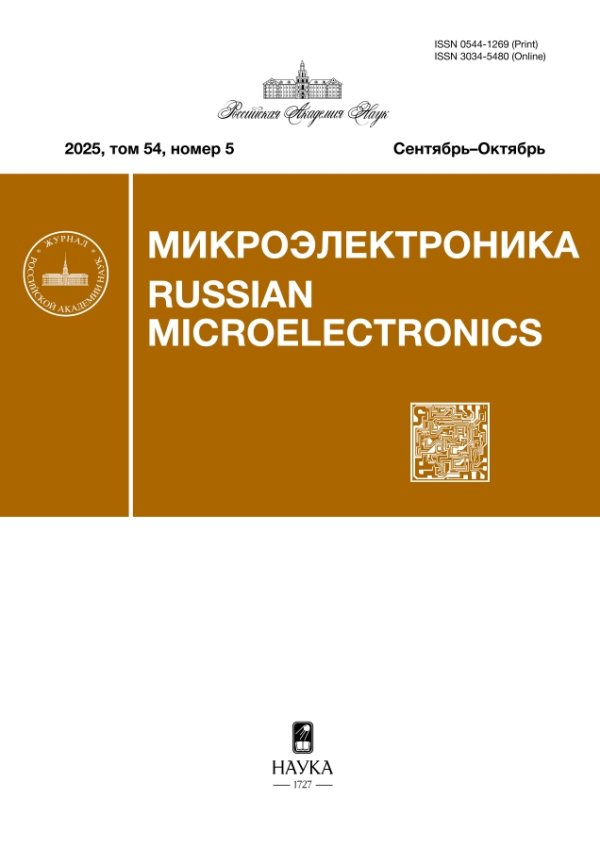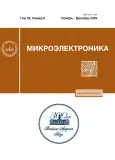Прототипы приборов гетерогенной гибридной полупроводниковой электроники с встроенным биомолекулярным доменом
- Авторы: Баранов М.А.1, Карсеева Э.К.1, Цыбин О.Ю.1
-
Учреждения:
- Санкт-Петербургский политехнический университет Петра Великого
- Выпуск: Том 52, № 6 (2023)
- Страницы: 497-507
- Раздел: ПРИБОРЫ
- URL: https://journals.rcsi.science/0544-1269/article/view/231920
- DOI: https://doi.org/10.31857/S0544126923600185
- EDN: https://elibrary.ru/UXDIUD
- ID: 231920
Цитировать
Полный текст
Аннотация
Макромолекулярная система, встраиваемая в полупроводниковый микроэлектронный прибор, рассмотрена в виде биомолекулярного нано или микро размерного домена, выполняющего функции преобразования акустоэлектронных и электромагнитных сигналов. Обсуждены вопросы выбора веществ, структурного, динамического и функционального состояния домена, а также физические основы его взаимодействия с элементами матрицы. Методом суперкомпьютерного неравновесного моделирования молекулярной динамики исследован процесс возбуждения вынужденных колебаний в молекулах аминокислот (на примерах глицина, триптофана, дифенил-L-аланина) при воздействии коротких (10–100 пс) пакетов электрических сигналов ИК диапазона с несущей частотой в интервале 0.5–125 ТГц. Акустоэлектронная интерпретация генерации колебаний осуществлена с помощью адаптированной эквивалентной схемы пептидной группы. Приведены примеры разрабатываемых прототипов гетерогенных приборов. Сделан вывод о том, что встраиваемые биомолекулярные домены могут стать основой многофункциональной элементной базы, перспективной для преобразования сигналов в гибридной микроэлектронике.
Об авторах
М. А. Баранов
Санкт-Петербургский политехнический университет Петра Великого
Email: baranovma1993@gmail.com
Россия, 195251, Санкт-Петербург, ул. Политехническая, 29
Э. К. Карсеева
Санкт-Петербургский политехнический университет Петра Великого
Email: baranovma1993@gmail.com
Россия, 195251, Санкт-Петербург, ул. Политехническая, 29
О. Ю. Цыбин
Санкт-Петербургский политехнический университет Петра Великого
Автор, ответственный за переписку.
Email: baranovma1993@gmail.com
Россия, 195251, Санкт-Петербург, ул. Политехническая, 29
Список литературы
- Roco M.C. The long view of nanotechnology development: The National Nanotechnology Initiative at 10 years // J. Nanoparticle Research. 2011. V. 13. № 2. P. 427–445. https://doi.org/10.1007/s11051-010-0192-z
- IEEE International Roadmap for Devices and Systems – IEEE IRDS. 2020. Accessed: Apr. 04, 2023. [Online]. Available: https://irds.ieee.org/.
- Apter B., Lapshina N., Handelman A., Fainberg B.D., Rosenman G. Peptide Nanophotonics: From Optical Waveguiding to Precise Medicine and Multifunctional Biochips // Small. 2018. V. 14. № 34. https://doi.org/10.1002/smll.201801147
- Heni W. et al. Silicon-Organic and Plasmonic-Organic Hybrid Photonics // American Chemical Society. 2017. V. 4. № 7. P. 1576–1590. https://doi.org/10.1021/acsphotonics.7b00224
- Пугачев А., Ожогин И., Козленко А. Новый негативно фотохромный спиропиран для элементов молекулярной электроники и фотовольтаики. Проблемы разработки перспективных микро- и наноэлектронных систем. 2021. V. 4. P. 155–161.
- Pugachev A.D. et al. New spiropyrans for creating elements of molecular electronics and photonics // Probl. Adv. micro- Nanoelectron. Syst. Dev. 2020. P. 139–146. https://doi.org/10.31114/2078-7707-2020-3-139-146
- Huang X., Li T. Recent progress in the development of molecular-scale electronics based on photoswitchable molecules // J. Materials Chemistry C. 2020. V. 8. № 3. P. 821–848. https://doi.org/10.1039/c9tc06054e
- Liu G. Grand Challenges in Biosensors and Biomolecular Electronics // Front. Bioeng. Biotechnol. 2021. V. 9. https://doi.org/10.3389/fbioe.2021.707615
- Величко Е.Н., Цыбин О.Ю. Гибридная биомолекулярная электроника: монография-СПб.: Политех-Пресс, 2021. 261 с. ISBN 978-5-7422-7302-8
- Dunn K., Trefzer M., Johnson S., Tyrrell A. Towards a Bioelectronic Computer: A Theoretical Study of a Multi-Layer Biomolecular Computing System That Can Process Electronic Inputs // Int. J. Mol. Sci. 2018. V. 19. № 9. P. 2620. https://doi.org/10.3390/ijms19092620
- Ing N.L., El-Naggar M.Y., Hochbaum A.I. Going the Distance: Long-Range Conductivity in Protein and Peptide Bioelectronic Materials // J. Physical Chemistry B. 2018. V. 122. № 46. P. 10403–10423. https://doi.org/10.1021/acs.jpcb.8b07431
- Schiattarella C. et al. Solid-state optical properties of self-assembling amyloid-like peptides with different charged states at the terminal ends // Sci. Rep. 2022. V. 12. № 1. P. 1–10. https://doi.org/10.1038/s41598-021-04394-2
- Kovalchuk M.V. et al. Structural characteristics of lysozyme Langmuir layers grown on a liquid surface from an oligomeric mixture formed during the early stages of lysozyme crystallization // Thin Solid Films. 2019. V. 677. P. 13–21. https://doi.org/10.1016/j.tsf.2019.02.051
- Бойкова А.С. и др. Получение многослойных пленок на основе белка лизоцима и ионов осадителя (йода и калия) на кремниевой подложке модифицированным методом Ленгмюра–Шеффера // Кристаллография. 2018. Т. 63. № 5. С. 703–707. https://doi.org/10.1134/s0023476118050065
- Ковальчук М. и др. Модификация метода Ленгмюра-Шеффера для получения упорядоченных белковых пленок // Кристаллография. 2017. Т. 62. № 4. С. 650–656.
- Baranov M., Tsybin O., Velichko E. Structured biomolecular films for microelectronics // St. Petersbg. Polytech. State Univ. J. Phys. Math. 2021. V. 14. № 1. P. 85–99. https://doi.org/10.18721/JPM.14106
- Velichko E., Zezina T., Baranov M., Nepomnyashchaya E., Tsybin O. Dynamics of Polypeptide Cluster Dipole Moment for Nano Communication Applications // Lect. Notes Comput. Sci. (including Subser. Lect. Notes Artif. Intell. Lect. Notes Bioinformatics), 2018. V. 11118 LNCS. P. 675–682. https://doi.org/10.1007/978-3-030-01168-0_62
- Velichko E., Zezina T., Cheremiskina A., Tsybin O. Nano communication device with embedded molecular films: Effect of electromagnetic field and dipole moment dynamics,” Lect. Notes Comput. Sci. (including Subser. Lect. Notes Artif. Intell. Lect. Notes Bioinformatics). 2015. V. 9247. P. 765–771. https://doi.org/10.1007/978-3-319-23126-6_71
- Tsybin O. Nano-device with an embedded molecular film: Mechanisms of excitation // in Lecture Notes in Computer Science (including subseries Lecture Notes in Artificial Intelligence and Lecture Notes in Bioinformatics). 2015. V. 9247. P. 772–777. https://doi.org/10.1007/978-3-319-23126-6_72
- Непомнящая Э.К., Баранов М.А., Цыбин О.Ю. Компьютерная резонансная динамика молекулы глицина в электрическом поле инфракрасного диапазона // Письма в ЖТФ. 2023. Т. 49. № 7. С. 8–11. https://doi.org/10.21883/PJTF.2023.07.54913.19435
- Fröhlich H. The Biological Effects of Microwaves and Related Questions. Elsevier, UK, 1980. P. 85–152.
- Millefiori S., Alparone A., Millefiori A., Vanella A. Electronic and vibrational polarizabilities of the twenty naturally occurring amino acids // Biophys. Chem. 2008. V. 132. № 2–3. P. 139–147. https://doi.org/10.1016/j.bpc.2007.11.003
- Wang W.N., Li H.Q., Zhang Y., Zhang C.L. Correlations between terahertz spectra and molecular structures of 20 standard α-amino acids // Acta Phys. Chim. Sin. 2009. V. 25. № 10. P. 2074–2079. https://doi.org/10.3866/pku.whxb20090931
- Barth A., Zscherp C. What vibrations tell us about proteins // Q. Rev. Biophys. 2002. V. 35. № 4. P. 369–430. https://doi.org/10.1017/S0033583502003815
- Mohamed M.E., Mohammed A.M.A. Experimental and Computational Vibration Study of Amino Acids // Int. Lett. Chem. Phys. Astron. 2013. V. 15. № 1. P. 1–17. https://doi.org/10.56431/p-177d2l
- Matei A., Drichko N., Gompf B., Dressel M. Far-infrared spectra of amino acids // Chem. Phys. 2005. V. 316. № 1–3. P. 61–71. https://doi.org/10.1016/j.chemphys.2005.04.033
- Wolpert M., Hellwig P. Infrared spectra and molar absorption coefficients of the 20 alpha amino acids in aqueous solutions in the spectral range from 1800 to 500 cm–1 // Spectrochim. Acta Part A Mol. Biomol. Spectrosc. 2006. V. 64. № 4. P. 987–1001. https://doi.org/10.1016/j.saa.2005.08.025
- Zhang F., Tominaga K., Hayashi M., Wang H.-W. Low-frequency vibration study of amino acids using terahertz spectroscopy and solid-state density functional theory // in Infrared, Millimeter-Wave, and Terahertz Technologies III. 2014. V. 9275. P. 92750D. https://doi.org/10.1117/12.2071528
- Yi W. et al. Broadband terahertz spectroscopy of amino acids // Instrum. Sci. Technol. 2017. V. 45. № 4. P. 423–439. https://doi.org/10.1080/10739149.2016.1270961
- Зезина Т.И., Цыбин О.Ю. Субпикосекундная динамика дипольного момента молекулярных полиаланинов // Научно-технические ведомости СПбГПУ. Физико-математические науки. 2017. Т. 10. № 4. С. 100–110. https://doi.org/10.18721/JPM.10408
- Deniz E. et al. Through bonds or contacts? Mapping protein vibrational energy transfer using non-canonical amino acids // Nat. Commun. 2021. V. 12. № 1. P. 3284. https://doi.org/10.1038/s41467-021-23591-1
- Mancini T., Mosetti R., Marcelli A., Petrarca M., Lupi S., D’arco A. Terahertz Spectroscopic Analysis in Protein Dynamics: Current Status // Radiation. 2022. V. 2. № 1. P. 100–123. https://doi.org/10.3390/radiation2010008
- English N.J., Waldron C.J. Perspectives on external electric fields in molecular simulation: Progress, prospects and challenges // Phys. Chem. Chem. Phys. 2015. V. 17. № 19. P. 12407–12440. https://doi.org/10.1039/c5cp00629e
- Kelly C.M. et al. Conformational dynamics and aggregation behavior of piezoelectric diphenylalanine peptides in an external electric field // Biophys. Chem. 2015. V. 196. P. 16–24. https://doi.org/10.1016/j.bpc.2014.08.009
- Reale R., English N.J., Marracino P., Liberti M., Apollonio F. Dipolar response and hydrogen-bond kinetics in liquid water in square-wave time-varying electric fields // Mol. Phys. 2014. V. 112. № 14. P. 1870–1878. https://doi.org/10.1080/00268976.2013.867081
- He L., Dexter A.F., Middelberg A.P.J. Biomolecular engineering at interfaces // Chem. Eng. Sci. 2006. V. 61. № 3. P. 989–1003. https://doi.org/10.1016/j.ces.2005.05.064
- Lenci S., Tedeschi L., Pieri F., Domenici C. UV lithography-based protein patterning on silicon: Towards the integration of bioactive surfaces and CMOS electronics // A-ppl. Surf. Sci. 2011. V. 257. № 20. P. 8413–8419. https://doi.org/10.1016/j.apsusc.2011.04.096
- Kislov V.V. et al. Electronics of molecular nanoclusters // Int. J. Nanosci. 2004. V. 3. № 1–2. P. 137–147. https://doi.org/10.1142/S0219581X04001912
- Баранов М.А., Цыбин О.Ю., Величко Е.Н. Структурированные биомолекулярные пленки для микроэлектроники // Научно-технические ведомости СПбГПУ. Физико-математические науки. 2021. Т. 14. № 1. С. 85–99. https://doi.org/10.18721/JPM.14106
- Gatto E., Toniolo C., Venanzi M. Peptide self-assembled nanostructures: From models to therapeutic peptides // Nanomaterials. 2022. V. 12(3). P. 456. https://doi.org/10.3390/nano12030466
- Baranov M., Velichko E., Tsybin O. Self-assembled biomolecular films as a new material for nano-telecommunication devices // in Lecture Notes in Computer Science (including subseries Lecture Notes in Artificial Intelligence and Lecture Notes in Bioinformatics). 2020. V. 12526 LNCS. P. 384–393. https://doi.org/10.1007/978-3-030-65729-1_34
- Ravanfar R., Bayles C.J., Abbaspourrad A. Structural chemistry enables fluorescence of amino acids in the crystalline solid state // Cryst. Growth Des. 2020. V. 20(3). P. 1673–1680. https://doi.org/10.1021/acs.cgd.9b01430
- Deveaud B. The Physics of Semiconductor Microcavities: From Fundamentals to Nanoscale Devices. John Wiley and Sons, 2007.
- Toptygin I.N. Electromagnetic phenomena in matter: Statistical and quantum approaches. Wiley-VCH Verlag GmbH & Co. KGaA, Weinheim, Germany, 2015.
- Величко Е., Цыбин О. Биомолекулярный сенсор с микроэлектронным генератором электромагнитной волны. патент RU 2749698 С1, 2021.
- Dyubo D., Tsybin O.Y. Nano communication device with an embedded molecular film: Electromagnetic signals integration with dynamic operation photodetector // Lect. Notes Comput. Sci. (including Subser. Lect. Notes Artif. Intell. Lect. Notes Bioinformatics). 2017. V. 10531 LNCS. P. 206–213. https://doi.org/10.1007/978-3-319-67380-6_19
- Karothu D.P., Dushaq G., Ahmed E., Catalano L., Polavaram S., Ferreira R., Li L., Mohamed S., Rasras M., Naumov P. Mechanically robust amino acid crystals as fiber-optic transducers and wide bandpass filters for optical communication in the near-infrared // Nat. Commun. 2021. V. 12(1). P. 1326. https://doi.org/10.1038/s41467-021-21324-y
- Dyubo D., Tsybin O.Y. Computer simulation of a surface charge nanobiosensor with internal signal integration // Biosensors. 2021. V. 11. № 10. https://doi.org/10.3390/bios11100397
- Miao L., Seminario J.M. Molecular dynamics simulations of signal transmission through a glycine peptide chain // J. Chem. Phys. 2007. V. 127. № 13. https://doi.org/10.1063/1.2786078
- Celestin M., Krishnan S., Bhansali S., Stefanakos E., Goswami D.Y. A review of self-assembled monolayers as potential terahertz frequency tunnel diodes // Nano. Res. 2014. V. 7. № 5. P. 589–625. https://doi.org/10.1007/S12274-014-0429-8
- Dyubo D., Tsybin O.Y., Baranov M.A., Alekseenko A.P., Velichko E.N. Study of electric properties of self-assembled films of albumin during their dehydration Recent citations Study of electric properties of self-assembled films of albumin during their dehydration // J. Phys. 2018. V. 1124. № 3. P. 31013. https://doi.org/10.1088/1742-6596/1124/3/031013
- Baranov M., Velichko E., Greshnevikov K. Analysis of Fractal Structures in Dehydrated Films of Protein Solutions // Symmetry (Basel). 2021. V. 13. № 123. P. 1–11. https://doi.org/10.3390/sym13010123
- Nepomnyashchaya E., Baranov M., Tsybin O. Measurement of Refraction Coefficients in thin Biomolecular Films Studies; Measurement of Refraction Coefficients in thin Biomolecular Films Studies. Int. Conf. Electr. Eng. Photonics, 2022. https://doi.org/10.1109/EEXPOLYTECH56308.2022.9950914













